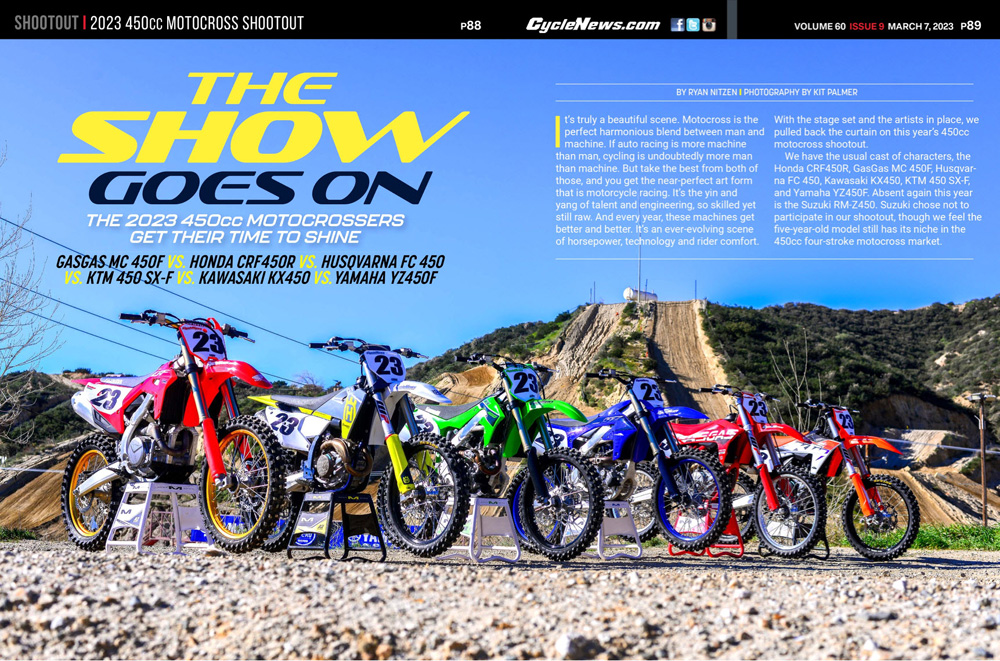Ryan Nitzen | March 13, 2023
It’s truly a beautiful scene. Motocross is the perfect harmonious blend between man and machine. If auto racing is more machine than man, cycling is undoubtedly more man than machine. But take the best from both of those, and you get the near-perfect art form that is motorcycle racing. It’s the yin and yang of talent and engineering, so skilled yet still raw. And every year, these machines get better and better. It’s an ever-evolving scene of horsepower, technology and rider comfort. With the stage set and the artists in place, we pulled back the curtain on this year’s 450cc motocross shootout.
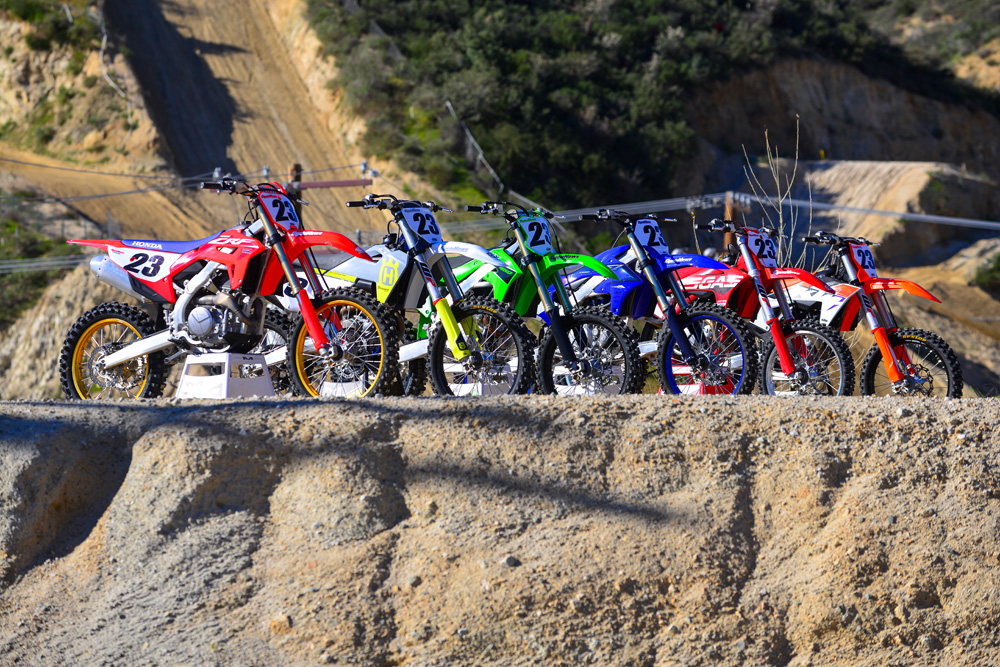
Photography by Kit Palmer
We have the usual cast of characters, the Honda CRF450R, GasGas MC 450F, Husqvarna FC 450, Kawasaki KX450, KTM 450 SX-F, and Yamaha YZ450F. Absent again this year is the Suzuki RM-Z450. Suzuki chose not to participate in our shootout, though we feel the five-year-old model still has its niche in the 450cc four-stroke motocross market.
The Cast | 2023 450cc Motocross Shootout
2023 GasGas MC 450F
MSRP: $10,199 Weight (wet): 236 lbs.
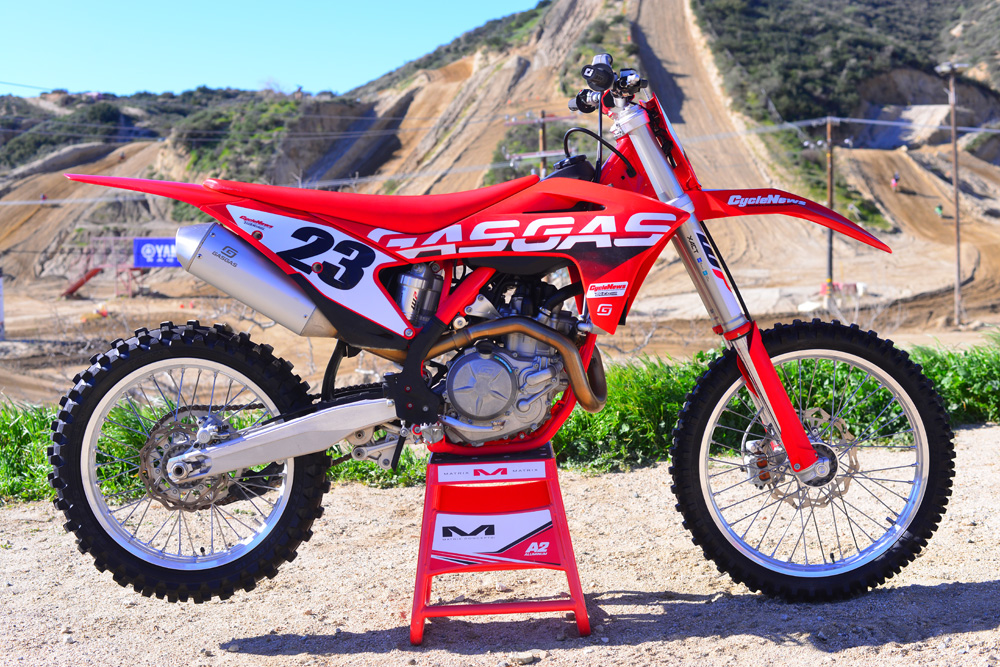
One of the unchanged bikes for this year is the 2023 GasGas MC 450F. GasGas is the third brand under the KTM Group umbrella and is marketed as a more fun and affordable option than the Husky and KTM. Therefore, it rides on last year’s technology, while the ’23 KTM and Husqvarna models receive complete redesigns. The GasGas has a steel frame, WP air forks, and Brembo brakes and clutch systems. The silver wheels, cast triple clamps, and no map switch add to its more straightforward nature. It is the most affordable of the three Austrian bikes and is the lightest of the group when measured fully fueled.
2023 Honda CRF450R
MSRP: $9599 base, $9899 as tested Weight (wet): 243 lbs.
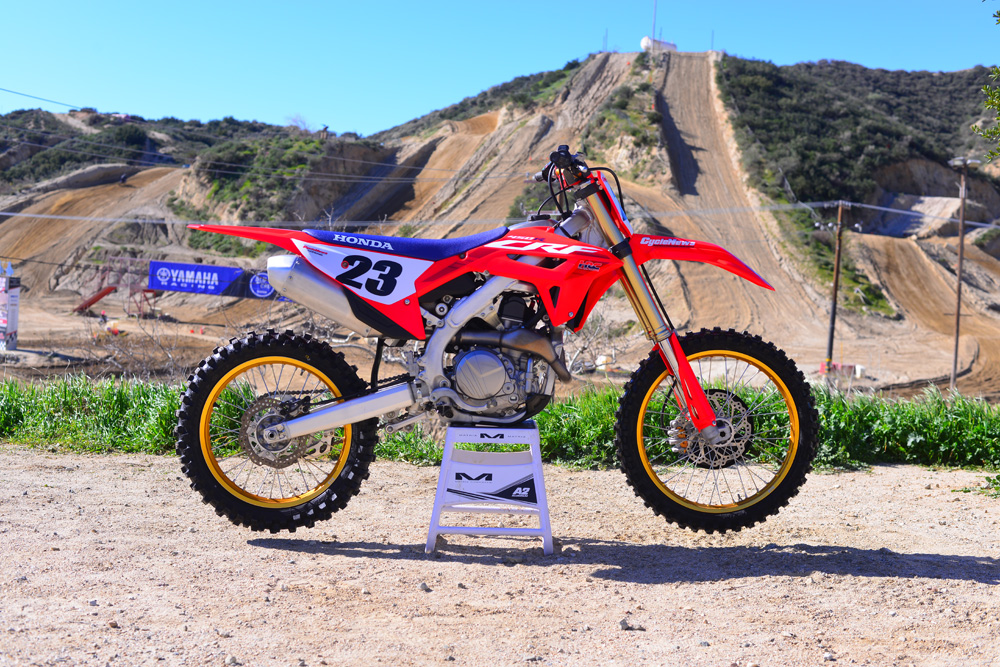
Honda’s flagship motocrosser is deep in its current generation, which launched in 2021. For this year, the frame was modified for added flex, and the suspension settings have been tuned to match. Honda says its goal was to free up the function of the bike while still letting the suspension, engine and frame flex individually. Several engine internals are smaller, too, with a narrower intake port, reduced throttle body, and a smaller exhaust. Overall, the bike’s been touched up to be a smoother package.
2023 Husqvarna FC 450
MSRP: $10,999 Weight (wet): 240 lbs.
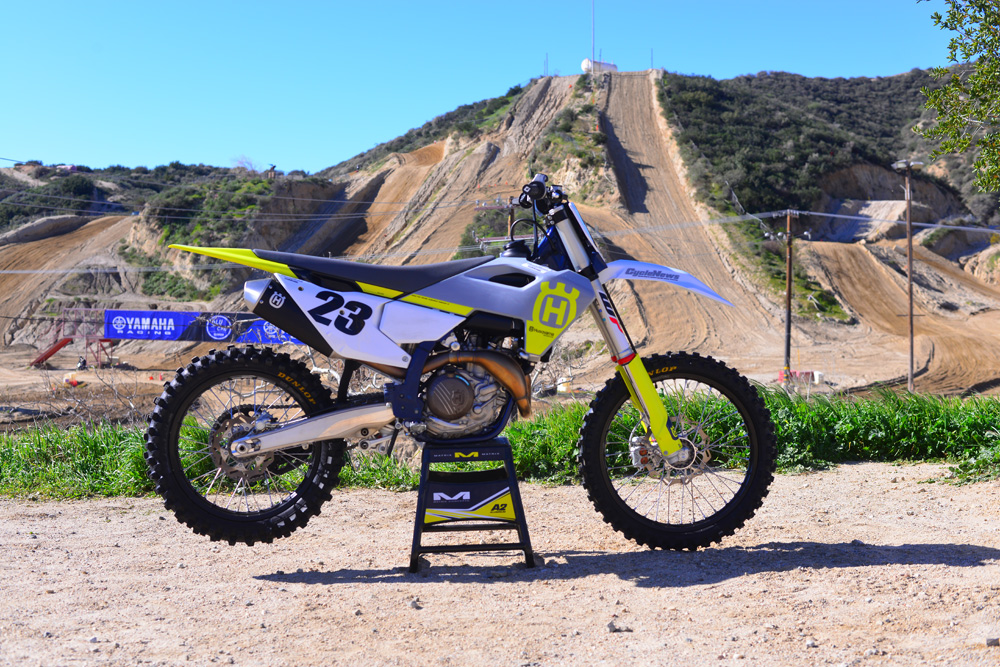
The Husqvarna FC 450 is all-new for 2023. Like its orange brother, it gets a new frame, engine and bodywork for the new year. The Husky is the premium of the Austrian bikes and comes with all the bells and whistles like traction control and a quickshifter. While the Husqvarna and the KTM ride on WP AER suspension, the most significant difference between the two is 10mm lower suspension on the FC 450. This, in turn, lowers the seat height by about an inch and the ground clearance by roughly half that. The new plastic and color scheme stand out as significant differences.
2023 Kawasaki KX450
MSRP: $9599 Weight (wet): 246 lbs.
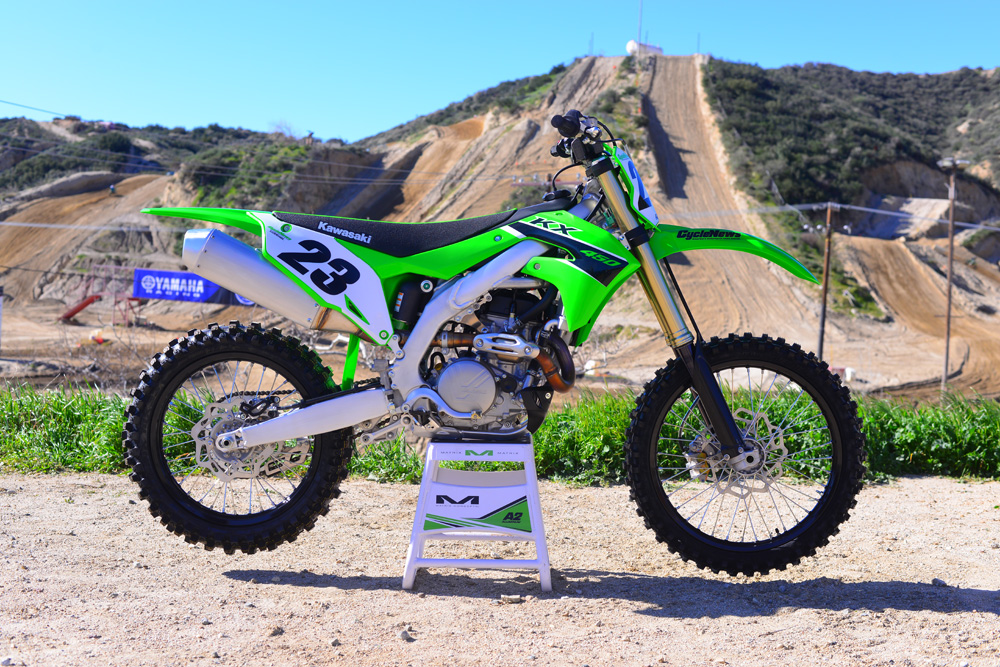
The Kawasaki KX450 returns for 2023 with virtually no changes. Since its inception in 2019, this generation KX has been a contender in nearly every shootout it’s entered. It comes standard with Kawasaki’s Ergo-Fit system, a hydraulic clutch, Showa suspension, and a three-coupler mapping system. With a full tank of fuel, it tips the scales as the heaviest bike of the bunch, save for the Suzuki, which, again, opted out of this year’s test. While others are all-new for this year, the KX’s tried and true character hopes to win over our riders.
2023 KTM 450 SX-F
MSRP: $10,899 Weight (wet): 239 lbs.
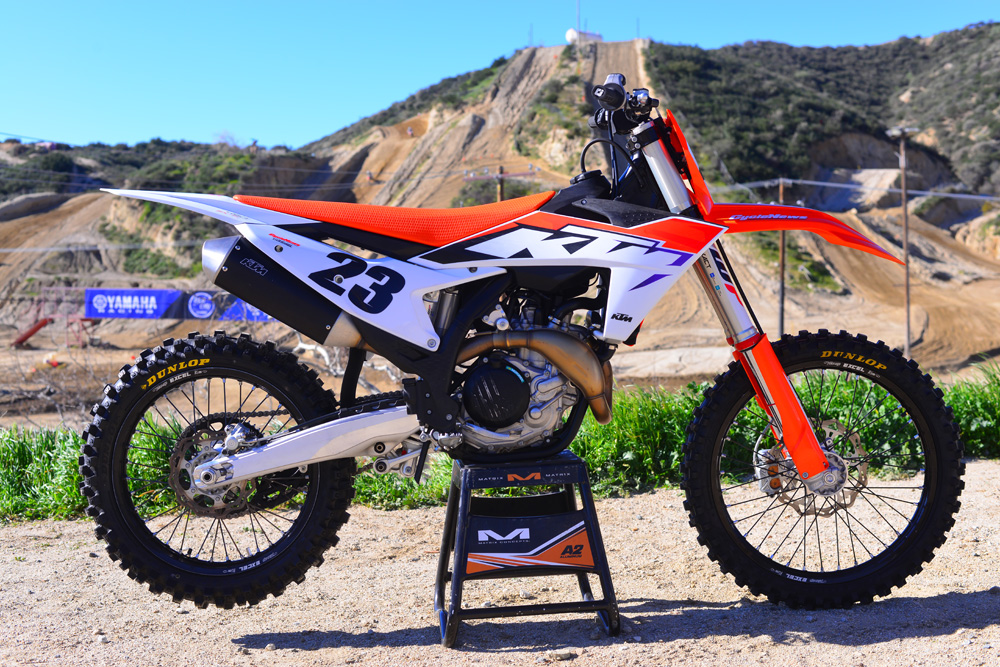
The KTM 450 SX-F enters the lineup considered as the “race ready” machine in the Austrian fleet. This is the current generation’s first year, with a new frame, motor, and electronics package. The SX-F has a dual-map switch, traction control and a new quickshift option. The engineers tweaked the shock mounting points in the frame but kept the familiar WP air forks and quality Brembo components. We’ve praised the KTM in the past for its lightweight nature, but it gained some weight during this update and lost its spot as the lightest in the class. At 239 pounds topped off, it’s now the second lightest bike of the group.
2023 Yamaha YZ450F
MSRP: $9899 Weight (wet): 241 lbs.
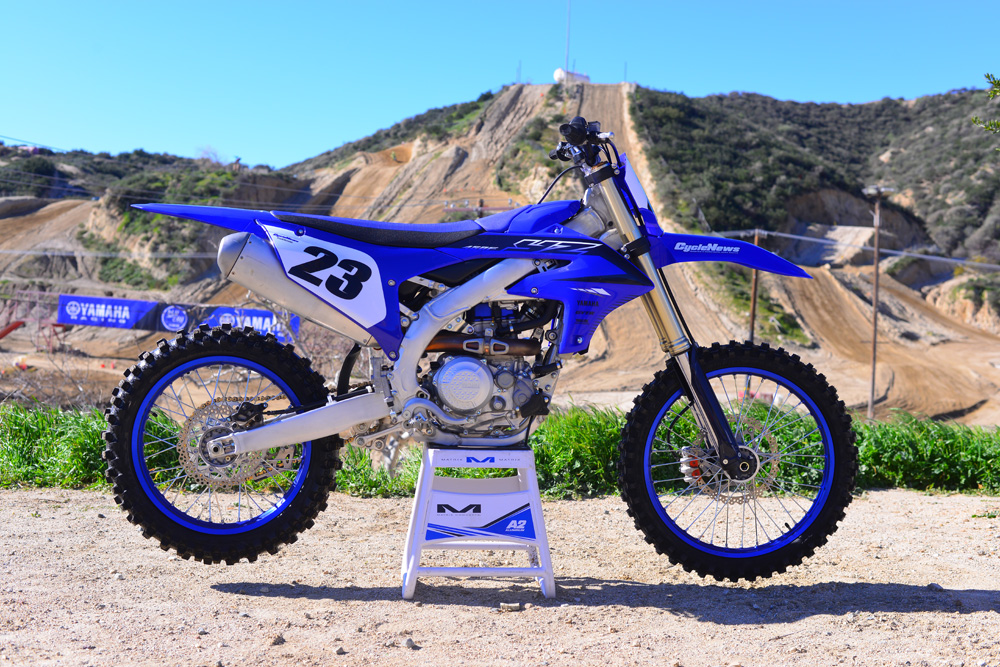
The most anticipated bike in this year’s lineup is the 2023 Yamaha YZ450F. The YZ-F enters an entirely new generation with a complete ground-up redesign. New frame, new motor, practically new everything. The Yamaha sheds five pounds from last year, three from the engine alone, and upped the rev limiter for increased power in the top-end range. They’ve also attempted to ditch that “wide” front-end feeling with slim new bodywork in the rider cockpit. Familiar KYB suspension and the easy-to-use Power Tuner App are back for 2023, but will the new YZ-F still be a contender for the shootout win?
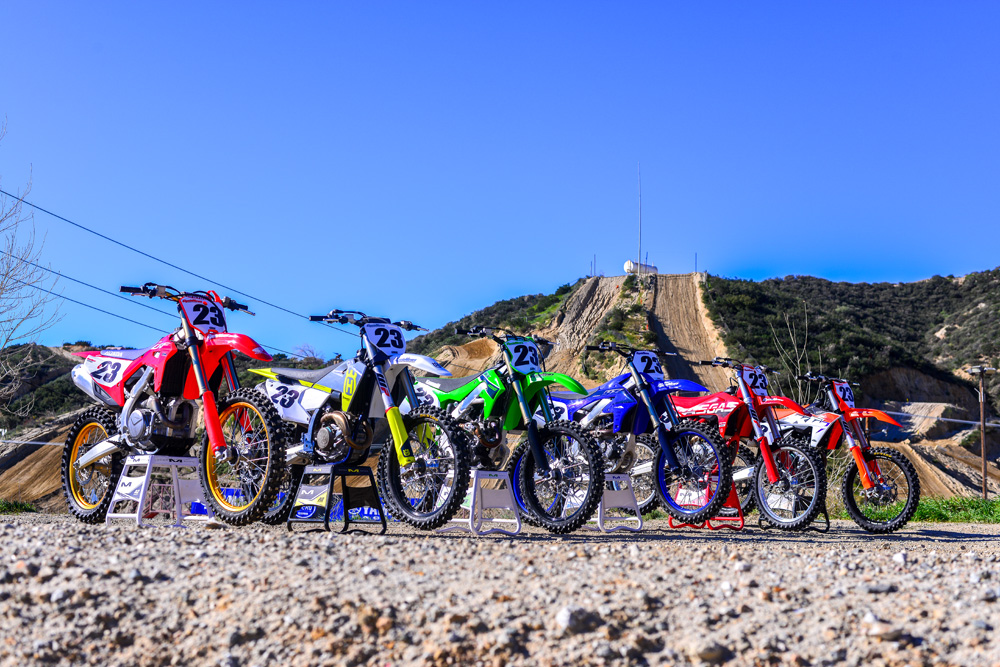
6th Place
Honda CRF450R
No one wants to say it, but one of these bikes must be picked last. And while it takes the cake by far in the looks department, the Honda CRF450R finds itself at the back of the pack in this year’s shootout.
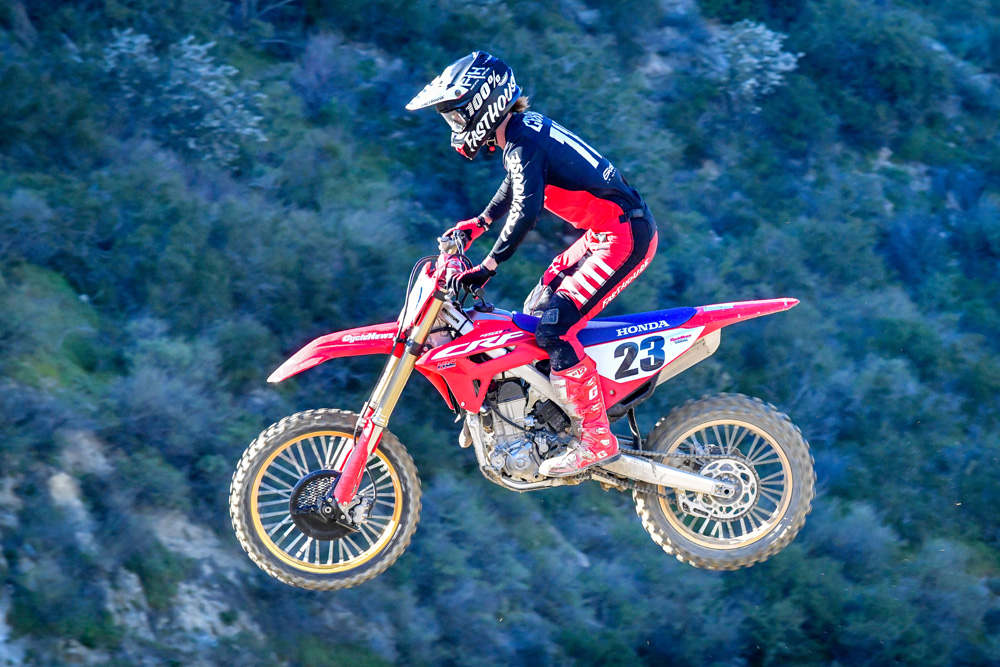
Let’s start with the good. We already mentioned the looks, especially its 50th-anniversary edition version. This package is $300 more than the standard R model but includes the gold wheels, blue seat cover, and special edition graphics. The classic retro theme tugs our nostalgic heartstrings in all the right ways. At $9599, the standard CRF450R, along with the KX450, is the most affordable (not including the $8999 Suzuki).
The ’23’s motor is an improvement from ’22. Overall, Honda has refined this engine package to be smoother and more rideable in all areas of the power curve. The three map settings are noticeably different. The faster riders favored the standard and aggressive maps (one and three), while the novice riders favored the smoother map two. Traction control is available on the Honda but is a hit-or-miss regarding rider preference.
The overall rider cockpit is slim and comfortable. Just what you’d expect from a Honda. In fact, all our riders picked the CRF as having one of the best-fitting cockpits. Sitting, standing and moving around on the bike is easy. This generation Honda sports a rounded seat and sharp styling, which is very Euro-esque if you ask us.
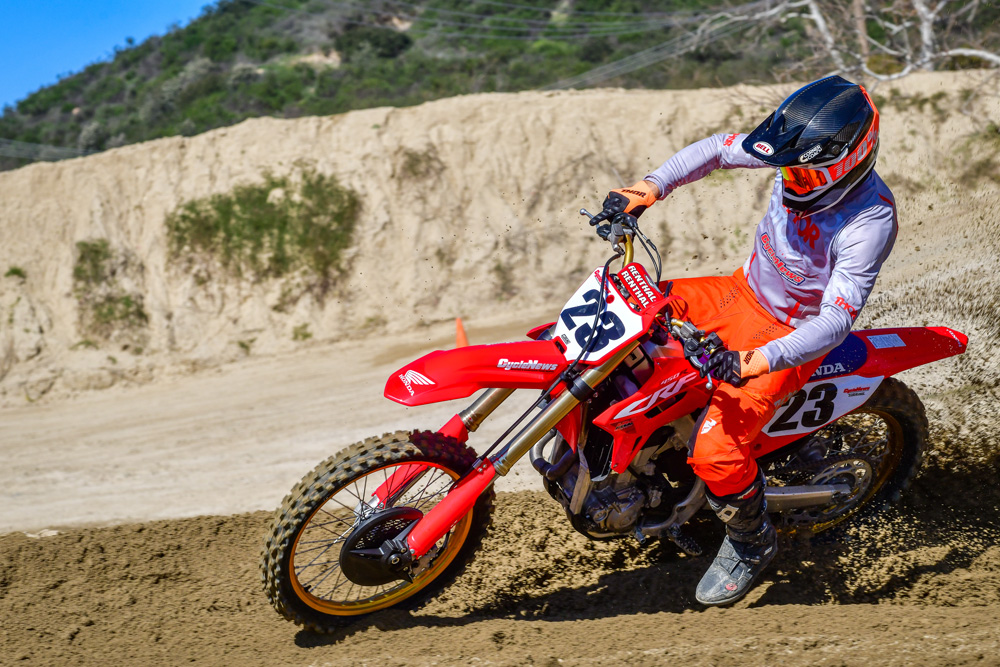
Unfortunately, its comfort can’t override its overly stiff or rigid chassis. Faster riders might not care as much, but once you back off the pro pace and enter the zone where most of us mortal humans reside, the bike gets harder to ride. The frame, suspension, clutch pull and even the grips are too harsh for us to enjoy for more than a few laps.
The deep, sandy conditions at Glen Helen masked this rigidity a bit, but the hard-packed dirt at Cahuilla showed the bike’s true nature as it bounced over the chattery bumps. Almost all our riders worked on this by softening both the fork and shock, which did help a bit but not enough.
The rigid character makes the bike feel heavy and less “flickable” when compared back-to-back with the others. This “heaviness” equates to the rear of the bike feeling planted and stable at speed, but then you’re fighting the lightweight and, at times twitchy, nature of the front end. It’s a battle we had a hard time fighting.
This result comes as a surprise to all of us as we loved this bike during our long-term test earlier in the year. The Honda’s power is smooth and predictable, and it rides with some of the best ergos in the game. Unfortunately, the overly stiff nature of the CRF drops it to sixth in our ranks.
Fifth Place
Husqvarna FC 450
Up next is the Husqvarna FC 450. Third through fifth place were the closest in the test with all three positions nearly tying in our overall points system, which we use to help us rank the bikes. So again, consider it our opinion since this next pack could likely be interchanged with different riders or a wider variety of track conditions.
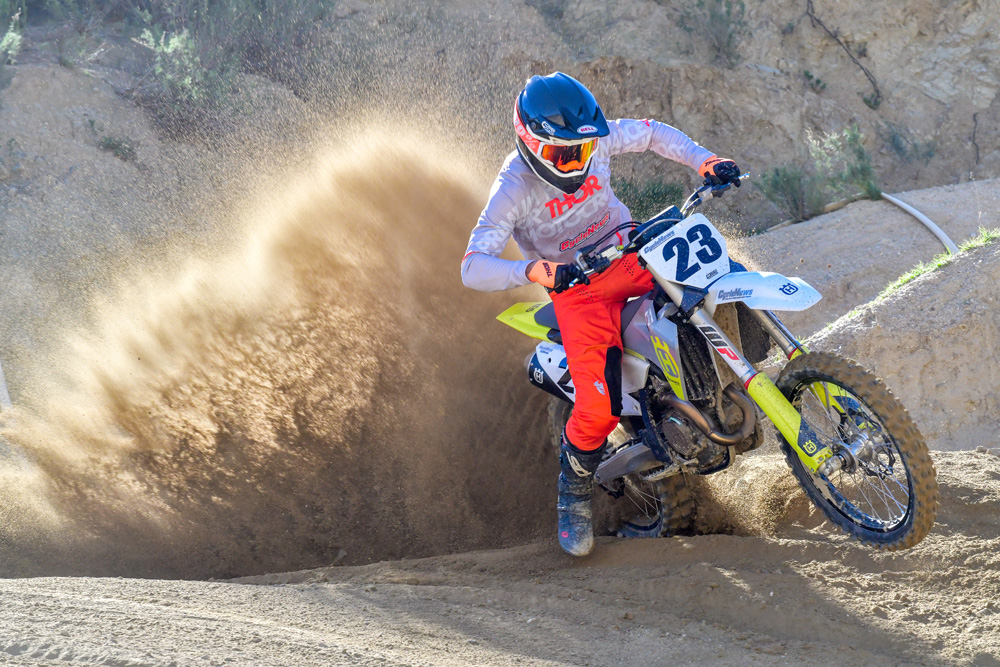
The Husky is one of three all-new bikes in the lineup. This can be a blessing or a curse, and a manufacturer rarely nails a new-gen design in their first model year. The Husqvarna receives polarizing results as it’s either loved or hated depending on the rider at the controls. It ranked as high as second and as low as sixth in our individual results.
One thing we all agreed on is the smoothness of the overall package. Like the foaming brim of your favorite latte, the Husqvarna is velvety smooth from the first sip. This new engine offers excellent delivery but retains the classic long-revving character that the Austrian powerplants are known for. This is also where a difference from the KTM lies, as the Husqvarna’s airbox is slightly different for a bit calmer engine character. You can carry gears longer on these bikes and don’t need to waste energy shifting all over the track. In the same vein, it never feels like “too much” or like it will get away from you. The bike’s so smooth, in fact, that the more aggressive green map two was almost unanimously favored. On the other hand, the traction control and quickshifter were noted as cool add-ons but not necessary items.
The brakes and clutch are top-notch on the Husqvarna. Again, smooth is the first word that comes to mind. While some riders don’t love hydro clutches, the Brembo components on the FC offer comfortable modulation with identifiable engagement. Same with the brakes, as you can easily trust their strength during late braking on a steep downhill.
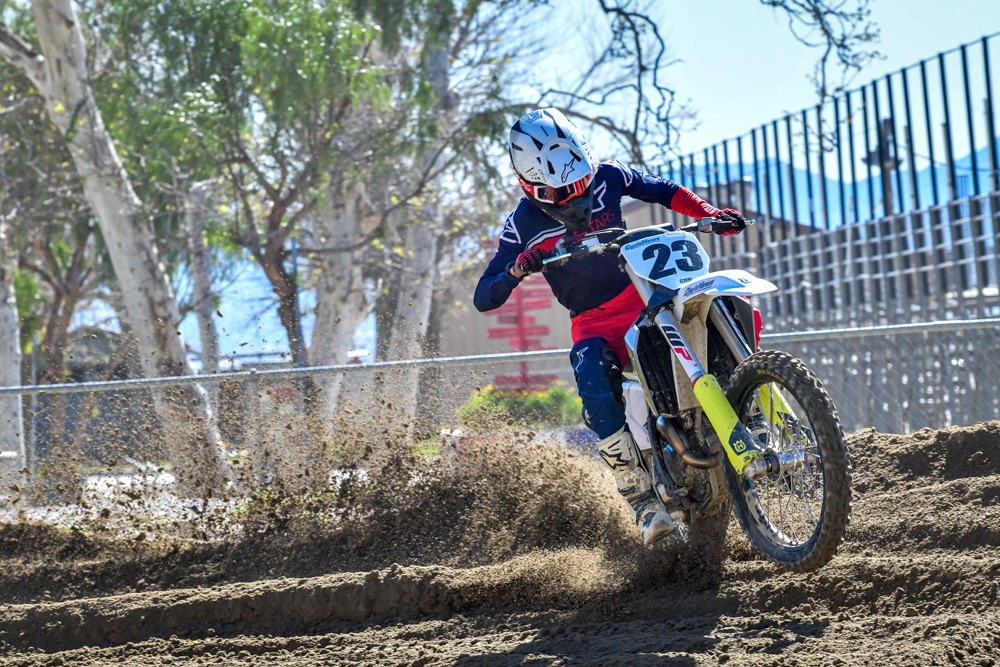
Things start to get tricky in the suspension department. The fork and shock on Husqvarna are 10mm lower than the KTM. This lowers the seat height by about an inch and puts the bottom of the bike about half an inch closer to the ground. The good part about this is it gives the bike a Velcroed feeling to the dirt. It feels planted to the ground, stable at speed, and is the undisputed king of flat turns. This bike excelled in the hard-packed conditions of Cahuilla Creek, as riders could slice across the track to avoid bumps late in the day. The swept-back bend of the ProTaper bars also contributes to an overall lower feeling.
The downside? This lowered character wasn’t favored by our taller riders. With most of our testers standing approximately in the five-foot-10-inch range, they noted the cockpit feeling small and cramped, making the transition from sitting to standing a bit harder. The shorter stature also gave us a feeling of the bike being longer than the others.
So, what’s the deciding factor? With third through fifth separated by only three points, we’re truly splitting hairs. Shorter riders will favor the Husqvarna, and taller guys will likely adapt well after bolting on their favorite bar bend.
Fourth Place
Yamaha YZ450F
Finishing just off the podium is the 2023 Yamaha YZ450F. The Yamaha is in a similar predicament to the Husqvarna, an all-new model year, and various rider opinions. One of our vets rated it his favorite, while our novice rider ranked it last.
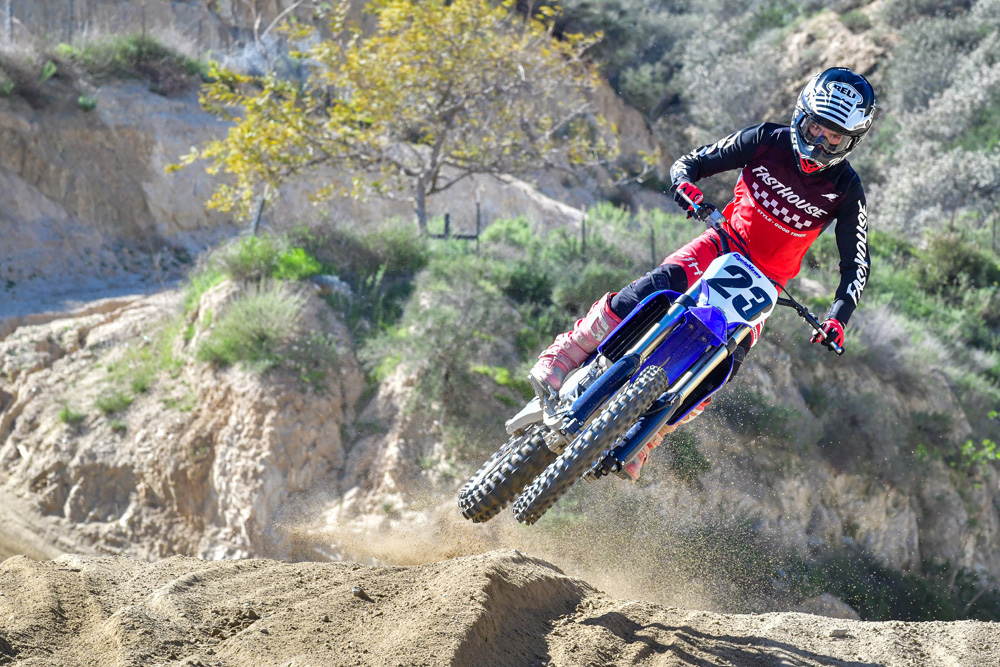
We had high expectations for the new Yamaha as the previous generation dominated shootouts for the past few years. The blue crew is on the right track with its new bike, but a few new-model bugs held it back.
No doubt, the Yamaha has the strongest motor in the group. This new engine is faster, revs higher and still maintains the tractability we liked from last year’s bike. It has a torquey bottom end that pulls wheelies out of the inside rut and transitions seamlessly into a meaty midrange. The rev limiter was bumped up 500 rpm, which puts the Yami on par with the Austrian bikes as you near the engine redline. Two maps are available via the handlebar switch, and all options we tried, including traction control, were well received. There isn’t anything to complain about here.
Yamaha virtually eliminated that “wide” feeling that many complained about with the previous generations. Now the bike is sharp and narrow while maintaining the front-facing airbox but redesigned to be quieter; that Yamaha vacuum noise is a thing of the past. The seat is thin and narrow and feels good. The YZ is comfortable.
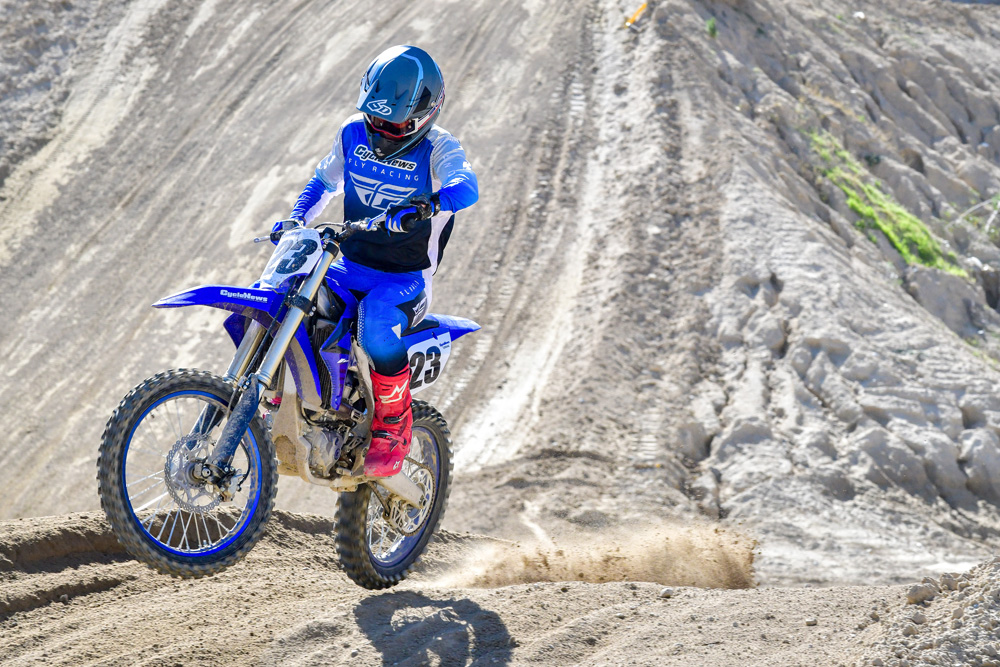
The YZ’s suspension shows good promise yet again. It’s the best fork in terms of initial comfort and provides good absorption from small bumps and big hits. The actual functionality of the Yamaha KYB components is just plain hard to beat. However, finding a good balance between the front and back is a different story.
When the front end was dialed, the rear felt out of line and unpredictable. When we got the rear feeling stable, the front felt vague and wanted to knife in the corners. We believe there is potential to get the front and back to work in harmony, but for us, there is only so much time in the day.
We liked the fork’s new toolless adjusters, making fork tuning much easier.
You also have Yamaha’s Power Tuner App, which is great for tuning the engine and maintaining the engine maintenance log. There are many things to like about the Yamaha.
3rd Place
GasGas MC 450F
If it ain’t broke, don’t fix it. That’s why the GasGas finds itself on the box, in third, for this year’s shootout. This bike has placed last, mid-pack, and now on the podium since it came on the scene a few years ago. While it hasn’t changed, the competition has. And safe to say this influences the MC 450F’s rank. As we said, third through fifth were almost too close to call, so keep that in mind, as the GasGas, the Yamaha, and the Husqvarna all ranked in neighboring territory.
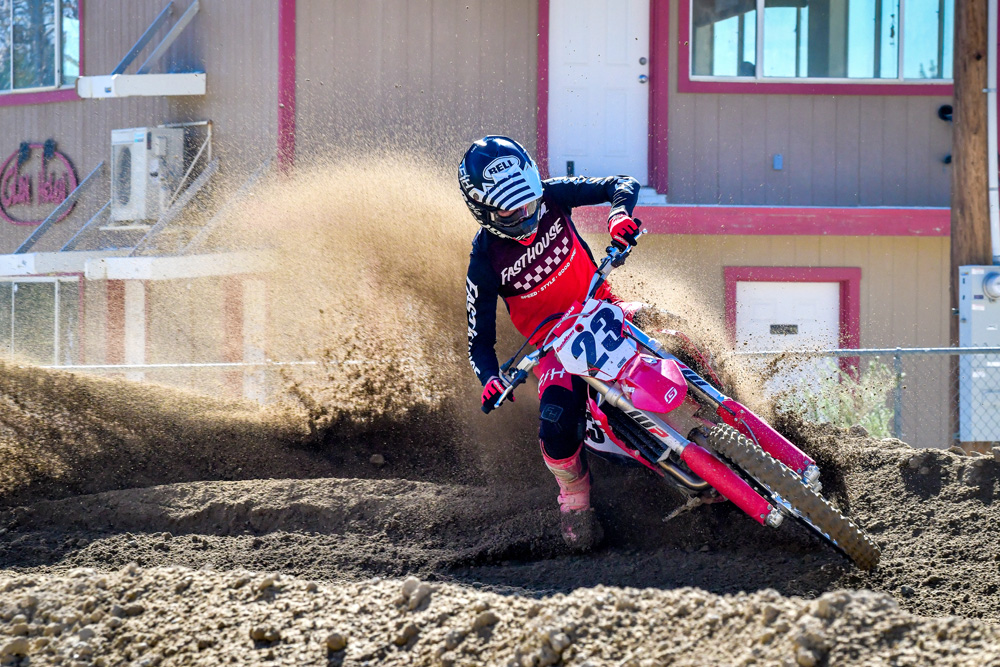
As with the competition, the GasGas ranked as high as first for our novices and farther back at times for our picky experts. Most votes averaged out to be 3.4 points compared to the Yamaha’s 3.5 and the Husqvarna’s 3.6 average scores. We told you it was close.
We like the GasGas for its easy-going personality. It’s not a firebreather like the Yamaha and is not as sporty as the KTM. The GasGas is just a strong, solid dirt bike that does everything it’s supposed to do. It rides on the previous-generation KTM frame, which was well-liked for its supple nature and good bump absorption. Like the other steel-framed bikes, the GasGas aces flat turns and transitions nicely from side to side. The WP air forks have softer settings than those on the KTM, and they aren’t the shorter spec like those on the Husky. This makes it feel less harsh, especially as the track wears out, and it allows our riders to hit bumps or chop without feeling like the bike was going too far into the stroke. One of our novice riders said this was the “most forgiving” bike, while our expert said he could “ride this bike all day long.”
The GasGas motor is another strong suit as it features that familiar Austrian engineering. It doesn’t come with a map switch, so riders only have one pre-programmed map in the bike (you can buy an aftermarket switch and load maps into it). The engine is smooth, less racey than the KTM but on par with the buttery roll-on of the Husqvarna. It offers that long spread between gears and shows its racer DNA by revving noticeably high, like the KTM and Husky.
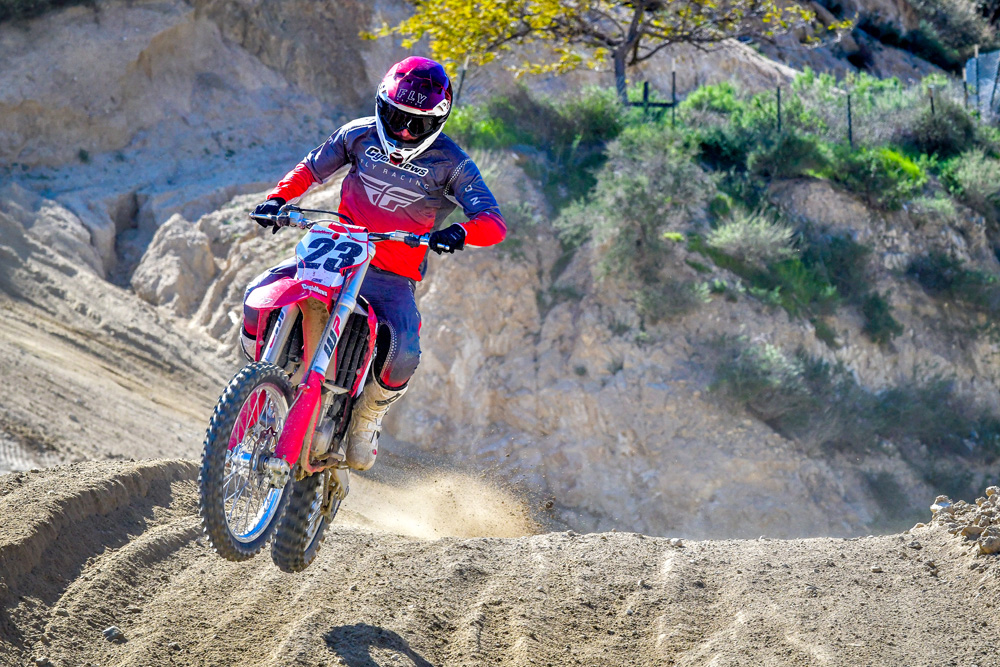
At 236 pounds with a full fuel tank, the GasGas is still four pounds lighter than any other bike in this test. You can feel that on the track as it floats lightly over jumps and seems to carry speed easily into corners. While also being the lightest Austrian bike on the wallet, the GasGas still comes with Brembo brakes and a Brembo hydraulic clutch system, arguably the best in the game.
The GasGas is a straightforward machine. No, it doesn’t come with all the bells and whistles, but it doesn’t really need them. The fact that it’s so easy to ride made us look past that this time around. If you don’t need traction control, quickshifter, name-brand bars, machined triple clamps and black wheels, then the MC 450F is right up your alley. Our crew concluded that we’d rather have a more well-rounded bike with less tech than a bike that lacks in a critical area but offers more whiz-bangs. Say what you will, but the GasGas rose into the top three with its no-nonsense trim and friendly character.
Second Place
Kawasaki KX450
With that closely spaced trio behind us, we move to the solid second-place finisher. The Kawasaki KX450 finds itself in the bridesmaid position despite being unchanged for the 2023 model year.

Here’s the thing about the Kawasaki. It sneaks its way into second place without jumping off the page or totally wowing the riders. What happens is you ride this bike and think, “Okay, this is good.” Then you jump on another bike and realize, “Wow, I wish this thing rode like the Kawi.” Once you take the KX out for a second spin, do you begin appreciating its well-rounded attributes.
It’s so planted and predictable that the laps flow together with noticeably less effort. The chassis is what you’d think of when you picture a standard Japanese motorcycle. Stable at speed through the fast stuff but still nimble enough to switch up your line and hit the insides. It’s not overly engineered and doesn’t have the rounded Euro-ish bodywork like the Yamaha, Honda or the GasGas.
Power on the Kawasaki also adds to that predictable feeling. It’s smooth where you want it, like the initial roll-on and how it carries through the revs. At the same time, it offers a good punch and encourages you to twist it to the limit. It’s an easy engine to ride and one of the only bikes where you feel you can reach your full potential. The connectivity from the grip to the rear wheel is hard to beat, and rider input feels like a seamless transition. In the past few years, modern 450s have verged on excessive horsepower, which almost limits the overall rideability. The Kawasaki is again reliable in terms of what we expect from the engine and, in turn, lands it near the top of the overall list.
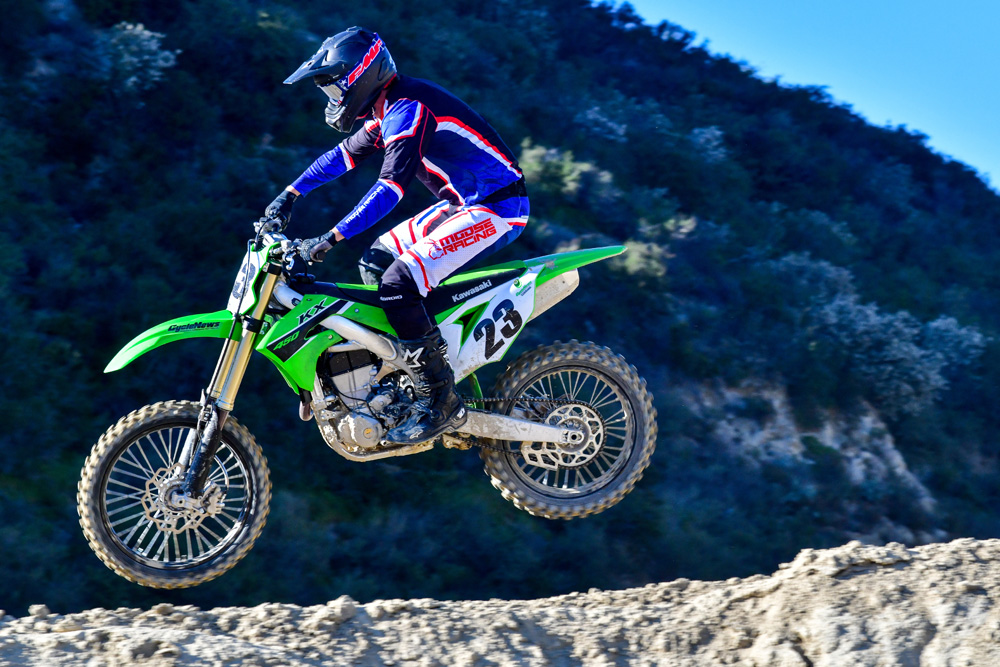
Showa suspension comes standard on the KX. This setup complements the chassis in a way that feels plush in the chattery bumps yet stiff enough to absorb a big landing. The best of both worlds. The rear end is planted to the ground and provides riders with the confidence to lay the power down and steer with the rear wheel. We made a few clicker adjustments to the rebound to get the fork to sit better when entering corners. Aside from that, the Kawi is solid for most abilities right out of the box.
So, if it’s so good, why didn’t it win? Good question. Little things. We still have a few complaints with the Kawi compared directly to the winner. The levers are our first point of deduction. We’ve said this since 2019, but these levers are just so foreign feeling that it’s hard to get used to. That, combined with the stock grips, is a no-go. This stands out since they are the main point of contact with the rider. Stock lock-ons would do wonders. Also, the Kawasaki is the heaviest bike, three pounds more than the winner. You don’t notice the weight while riding, but more weight is essentially lost horsepower. Finally, the mapping couplers aren’t a huge setback but they lose to handlebar switch every time. That’s the case here with the Kawi and the overall winner. Granted, as a bike you’re going to personalize, the Kawasaki could perhaps take the cake by replacing just the grips and levers. (And, while you’re at it, consider an upgraded chain guide and rear sprocket.) Rumors say the 2024 model will be all-new, so here’s hoping they touch up on these minor details.
First Place
KTM 450 SX-F
We said it’s rare that a manufacturer gets it right in their first model year. But when they do, it’s a treat for all parties involved. First up on our list is the all-new 2023 KTM 450 SX-F. The final Austrian machine received the most first-place votes and backed that up with nearly unanimous podium picks.
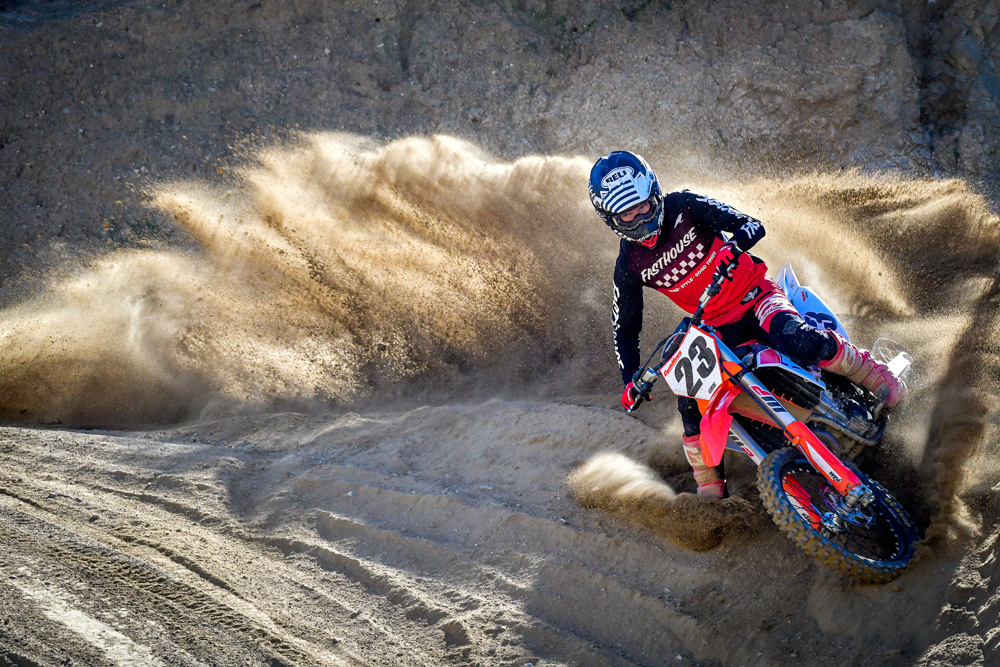
There’s no doubt that the KTM lives up to its Ready To Race mantra. This new engine is butter smooth, as we mentioned with the new Husqvarna. The difference here is the KTM’s airbox is a slightly different shape which gives it a bit livelier character. The KTM offers a good pop down low and still spools up fast as it has in the past. Again, this lets the riders carry gears longer on the orange bike than some of the other colors. Less shifting equals less energy and less thinking as you race around the track. We favored the more aggressive “map two” for its stronger pull from the bottom to midrange and used the traction control late in the day. The quickshift is a cool nuance but not necessary, at least now.
The chassis and suspension are all the good things we liked about the Husky, just without the lowered feeling. The Husqvarna may have won if it stood up a bit taller. The KTM feels narrow between the knees, and despite adding weight for this model year, the bike still feels light as you maneuver it in the air or from inside to outside. The new frame design still gives that supple-steel-frame feel in the choppy bumps but is responsive upon rider input, especially in flat turns when there’s no real rut to sink the bike in.
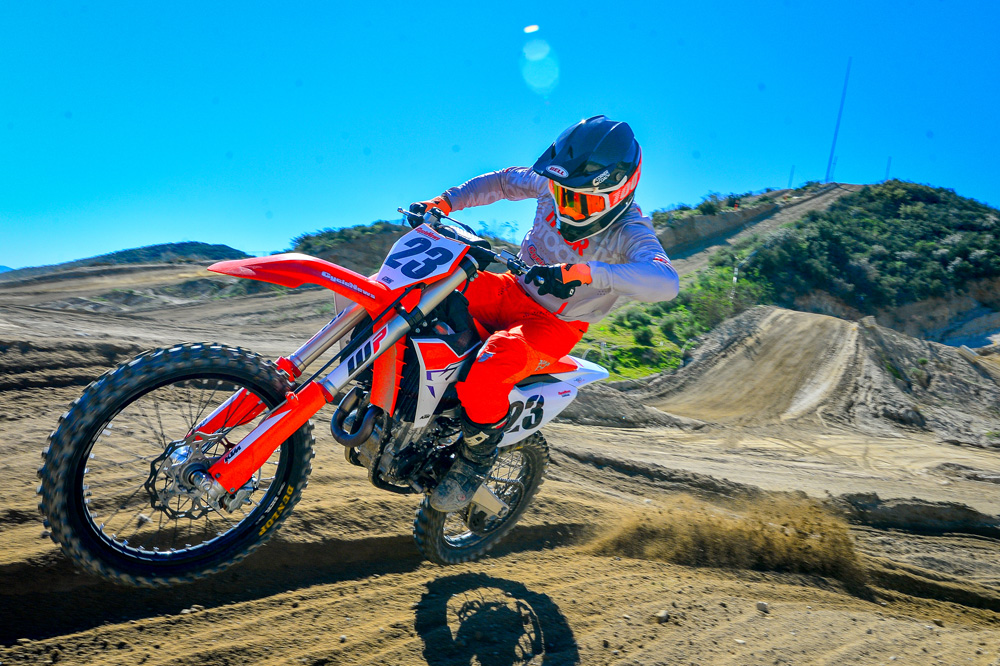
The WP air forks continue to impress us year after year. Sure, they’re a bit more work to set up with air pressure, and that might be a deal breaker for you, but the small bump absorption has improved drastically from just a few years ago. This bike can skip through braking bumps or take a big landing in stride. The shock is solid, too, as it tracks well even when the track starts to deteriorate. It never felt like it wanted to step out of line or get skatey, even when the conditions were less than ideal. The finger adjusters on the fork and shock also make trackside tuning a breeze.
Overall, the KTM was the easiest bike to ride and simply the easiest bike to adapt to over our testing. Our riders made the fewest changes to the SX-F and said that if they had to buy a bike on Friday and race it on Saturday, they would pick the KTM. Even the rider cockpit feels less Euro than in prior generations. It’s hard to beat the overall fit and finish of the modern-day KTM’s as they are truly a built-to-race machine. Winning in your first model year is tough, but the Orange Brigade brought the heat and took the W in 2023.
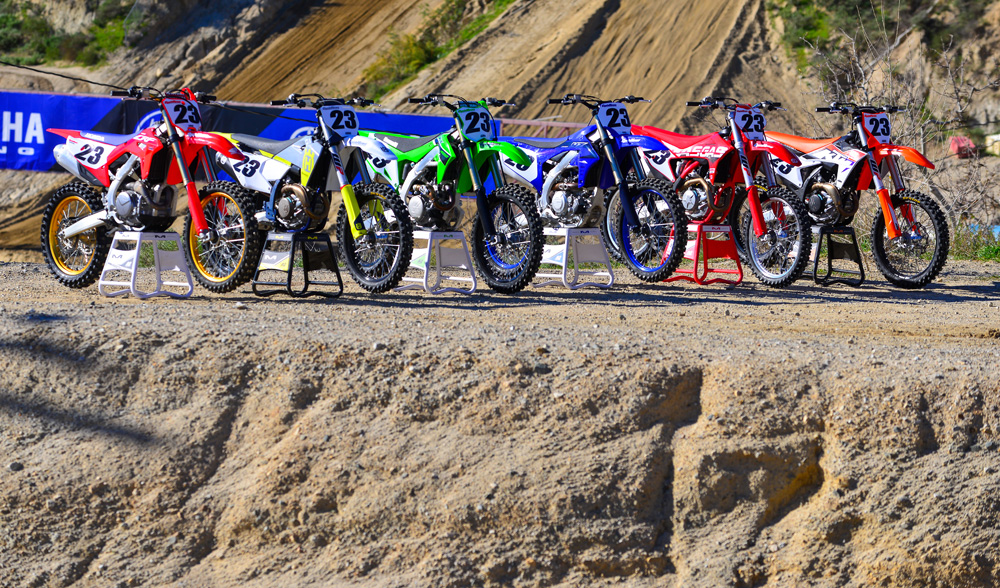
Wrap Up | 2023 450cc Motocross Shootout
While the KTM stole the show, the other bikes weren’t far behind. Three of these bikes were all-new this year, the KTM, the Yamaha and the Husqvarna, while the other three received minor or no updates. And if this were really the movies, we’d see individual mentions like the Honda winning best dressed, the Yamaha taking honors for strongest motor, Kawasaki as best supporting role, and the KTM earning best all around. More time with each of these rigs, or bolting on our personalized parts like bars, pegs, levers, etc., could easily mold any of these machines into a raceday superstar. But for now, we take them as they are and wait until next year to continue the next episode of shootout action.CN
VIDEO | Cycle News 2023 450 Motocross Shootout
2023 450 Motocross Shootout
